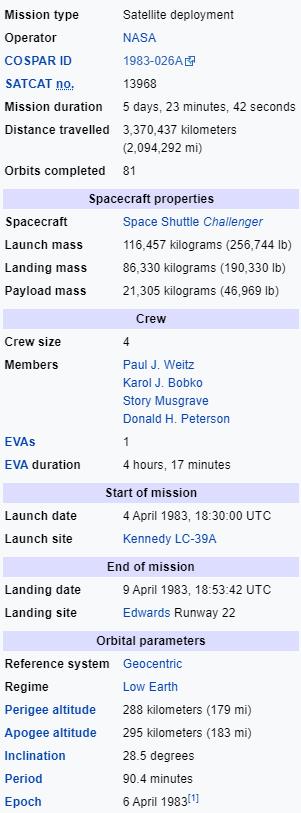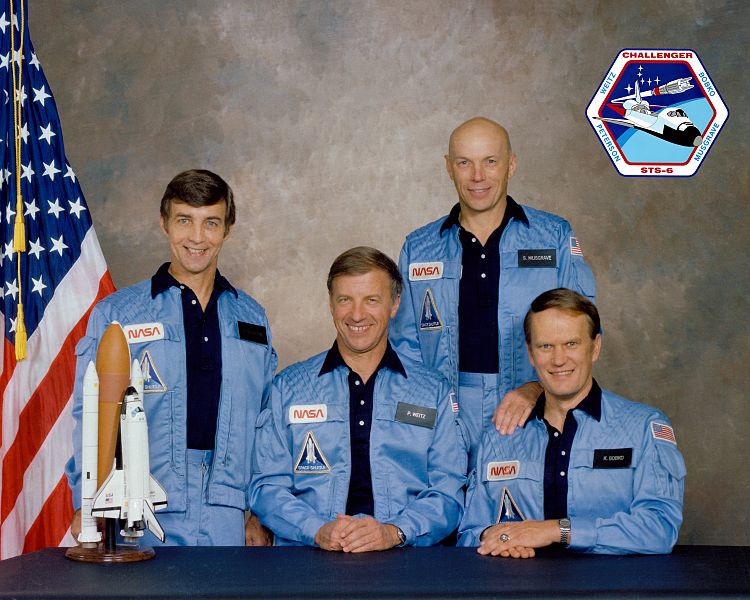Paul J. Weitz
Karol J. Bobko
F. Story Musgrave
William B. Lenoir
STS-6 was a NASA Space Shuttle mission conducted using Space Shuttle Challenger, carrying the first Tracking and Data Relay Satellite, TDRS-1, into orbit. Launched on 4 April 1983, STS-6 was the sixth shuttle mission and the first of the ten missions flown by Challenger. The mission took off from Kennedy's Space Centre's launch pad 39A, and landed at Edwards Air Force Base on 9 April. This was the first Space Shuttle mission during which a spacewalk was conducted, and the first in which the Extravehicular Mobility Unit (EMU) was used.
(First Space Flight) Mission Specialist 1:
(Only Space Flight) Mission Specialist 2:
(Second Space Flight & Last)
(First Space Flight)
Astronauts:
The Space Shuttle Missions
STS-6
Command Pilot:
Pilot:
Study
Research
Main Index
Space Cosmology
Science Research
*
About
Science Research
Science Theories
Desk
Site Map
BookShelf
Copyright © by Nigel G Wilcox · All Rights reserved · E-Mail: ngwilcox100@gmail.com
Designed by Nigel G Wilcox
Powered By AM3L1A
Pages within this section: USA Shuttle Mission Flights
STS-6
Pages within this section:
1
M
8
SM
Sub-Menu
menu
2
3
4
5
6
7
8
9
Support Crew
Roy D. Bridges Jr. (entry CAPCOM)
Mary L. Cleave
Richard O. Covey (ascent CAPCOM)
Guy S. Gardner
Jon A. McBride
Bryan D. O'Connor


The new orbiter was rolled out to LC-39A on a fog-shrouded morning in November 1982. On 18 December, Challenger was given a PFRF (Pre Flight Readiness Firing) to verify the operation of the main engines. The PFRF lasted for 16 seconds. Although engine operation was generally satisfactory, telemetry data indicated significant leakage of liquid hydrogen in the thrust section. However, it was not possible to determine the location of the leak with certainty, so program directors decided on a second PFRF with added telemetry probes. It was known that during the test run on 18 December, that recirculated exhaust gases and vibration leaked into the thrust section and this was considered a potential cause of the leak. Therefore, the original planned launch in late January 1983 had to be postponed.
On 25 January, a second PFRF was conducted which lasted 23 seconds and exhibited more hydrogen leaks. Eventually, it was found that low pressure ducting in the No. 1 engine was cracked. The engine was replaced by a spare, which was found to also have leaks. A third engine had to be ordered from Rocketdyne, and after thorough testing, turned out to be in proper operating condition. The No. 2 and No. 3 engines turned out to have leaks as well, and were taken out of the orbiter for repairs. By mid-March, the engine problems had been completely resolved.
While the engine repairs were underway on 28 February, a severe storm caused contamination of the mission's primary cargo, the first Tracking and Data Relay Satellite, TDRS-1, while it was in the Payload Change-out Room on the Rotating Service Structure at the launch pad. Consequently, the satellite had to be taken back to its checkout facility, where it was cleaned and rechecked. The Payload Change-out Room and the payload bay also had to be cleaned. All of these events pushed the launch back from 26 March to early April.
Data Courtesy Wikipedia.org












